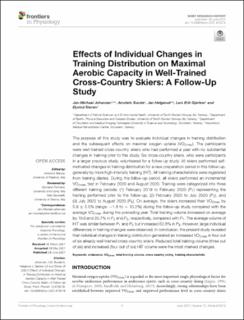| dc.contributor.author | Johansen, Jan-Michael | |
| dc.contributor.author | Sunde, Arnstein | |
| dc.contributor.author | Helgerud, Jan | |
| dc.contributor.author | Gjerløw, Lars Erik | |
| dc.contributor.author | Støren, Øyvind | |
| dc.date.accessioned | 2021-09-09T09:08:16Z | |
| dc.date.available | 2021-09-09T09:08:16Z | |
| dc.date.created | 2021-08-02T08:54:51Z | |
| dc.date.issued | 2021 | |
| dc.identifier.citation | Johansen, J.-M., Sunde, A., Helgerud, J., Gjerløw, L. E., & Støren, Ø. (2021). Effects of Individual Changes in Training Distribution on Maximal Aerobic Capacity in Well-Trained Cross-Country Skiers: A Follow-Up Study. Frontiers in Physiology, 12, Artikkel 675273. | en_US |
| dc.identifier.issn | 1664-042X | |
| dc.identifier.uri | https://hdl.handle.net/11250/2774879 | |
| dc.description.abstract | The purpose of this study was to evaluate individual changes in training distribution and the subsequent effects on maximal oxygen uptake (VO2max). The participants were well-trained cross-country skiers who had performed a year with no substantial changes in training prior to this study. Six cross-country skiers, who were participants in a larger previous study, volunteered for a follow-up study. All skiers performed self-motivated changes in training distribution for a new preparation period in this follow-up, generally by more high-intensity training (HIT). All training characteristics were registered from training diaries. During the follow-up period, all skiers performed an incremental VO2max test in February 2020 and August 2020. Training were categorized into three different training periods; (1) February 2019 to February 2020 (P1) representing the training performed prior to the follow-up, (2) February 2020 to July 2020 (P2), and (3) July 2020 to August 2020 (P3). On average, the skiers increased their VO2max by 5.8 ± 5.0% (range: −1.8 to + 10.2%) during the follow-up study compared with the average VO2max during the preceding year. Total training volume increased on average by 10.0 and 25.7% in P2 and P3, respectively, compared with P1. The average volume of HIT was similar between P1 and P2 but increased 62.8% in P3. However, large individual differences in training changes were observed. In conclusion, the present study revealed that individual changes in training distribution generated an increased VO2max in four out of six already well-trained cross-country skiers. Reduced total training volume (three out of six) and increased (four out of six) HIT volume were the most marked changes. | en_US |
| dc.language.iso | eng | en_US |
| dc.rights | Navngivelse 4.0 Internasjonal | * |
| dc.rights.uri | http://creativecommons.org/licenses/by/4.0/deed.no | * |
| dc.title | Effects of individual changes in training distribution on maximal aerobic capacity in well-trained cross-country skiers: A follow-up study | en_US |
| dc.type | Peer reviewed | en_US |
| dc.type | Journal article | en_US |
| dc.description.version | publishedVersion | en_US |
| dc.rights.holder | © 2021 Johansen, Sunde, Helgerud, Gjerløw and Støren. | en_US |
| dc.source.volume | 12 | en_US |
| dc.source.journal | Frontiers in Physiology | en_US |
| dc.identifier.doi | https://doi.org/10.3389/fphys.2021.675273 | |
| dc.identifier.cristin | 1923288 | |
| dc.source.articlenumber | 675273 | en_US |
| cristin.ispublished | true | |
| cristin.fulltext | original | |
| cristin.qualitycode | 1 | |

